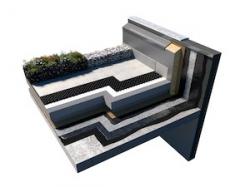Radmat Fire Regulation Compliance for Roofs
 Following the Grenfell Tragedy in June 2017, and the subsequent investigations, the Governments of England and Scotland made significant changes to their respective Regulations related to fire performance. Approved Document B Volumes 1 and 2 in England, and Technical Handbook Annex 2.C and 2.F in Scotland, introduced a new category of ‘relevant buildings’ with the aim of reducing the fire risk in high rise buildings (those over 18m in England and over 11m in Scotland).
Following the Grenfell Tragedy in June 2017, and the subsequent investigations, the Governments of England and Scotland made significant changes to their respective Regulations related to fire performance. Approved Document B Volumes 1 and 2 in England, and Technical Handbook Annex 2.C and 2.F in Scotland, introduced a new category of ‘relevant buildings’ with the aim of reducing the fire risk in high rise buildings (those over 18m in England and over 11m in Scotland).
Whilst generally clear with regards to the fire performance requirements for external wall construction (external wall systems on buildings over 18m high have to be fire resistant, achieving class than A2-s1, d0 or Class A1 under the European classification system set out in the standard BS EN 13501-1, subject to exemptions) the regulation changes have resulted in some confusion with regards to the fire performance requirements for roofing systems, and the definitions of ‘specified attachments’, insulated balconies, roof terraces and podiums.
With the entire UK Government in Purdah (the period leading up to an election, during which government departments generally refrain from making any new announcements) the Ministry of Housing, Communities and Local Government (MHCLG) are unable to make further clarifications, however what is clear is that:
Roofing systems must achieve Broof(t4) European classification in accordance with BS EN 13501-5.
Roof finishes covered under the Annex of Commission Decision 2000/553/EC are considered to be unrestricted under the national Requirements (Loose laid gravel with a thickness of at least 50 mm or a mass ≥ 80 kg/m2, Sand/cement screed to a thickness of at least 30 mm or Cast stone or mineral slabs of at least 40 mm thickness).
Any decoration or other finish applied to any external (but not internal) surface forming part of the wall must achieve class a minimum A2-s1, d0 classification to BS EN 13501-1.
This latter requirement means that any insulation board used as part of the roofing system where it abuts an external wall must be non-combustible, effectively banning the use of PIR, XPS and EPS insulation boards between the vertical waterproofing and the external wall.
In warm roof applications it is easy to switch the vertical upstand board in this application to mineral wool or cellular glass, but with no suitable product available for inverted roof applications specialist roofing system manufacturer Radmat Building Products had to develop a suitable solution quickly.
ProTherm RockFace A2, a non-combustible upstand insulation board for inverted roof applications, consists of a special mineral wool insulation board factory laminated to a 6mm Cement Particle board. This combination, tested by WarringtonFire to BSEN1350–1, achieved an A2-s1, d0 rating. Radmat Building Products believe that this is currently the only inverted roof upstand insulation board available that meets the requirements for ‘Relevant Buildings’ within Approved Document B, and the Scottish Technical Handbooks (those over 18 m in England and over 11m in Scotland).
For further information on RockFace A2, a copy of the WarringtonFire classification report no. 19808F dated 10 10 2019, or to find out about Radmat’s range of Regulatory compliant roofing systems go to www.radmat.com or call 01858 410372.